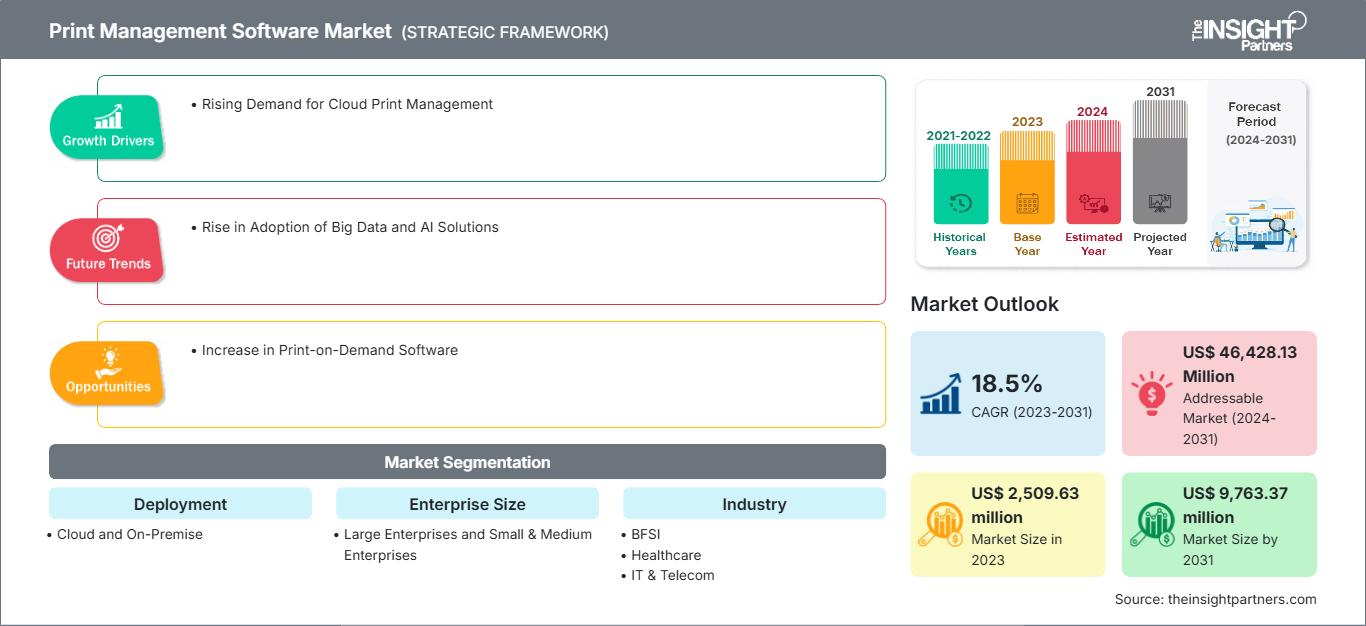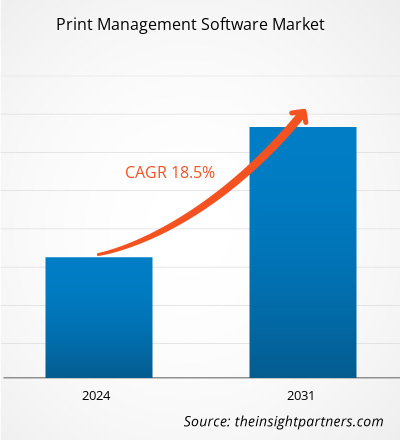Se prevé que el mercado de software de gestión de impresión alcance los 9.763,37 millones de dólares estadounidenses en 2031, frente a los 2.509,63 millones de dólares estadounidenses en 2023. Se espera que el mercado registre una tasa de crecimiento anual compuesta (TCAC) del 18,5 % durante el período 2023-2031. El aumento en la adopción de soluciones de macrodatos e inteligencia artificial probablemente seguirá siendo una tendencia clave en el mercado.
Análisis del mercado de software de gestión de impresión
Los principales actores del mercado de software de gestión de impresión incluyen proveedores de software, integradores de sistemas y usuarios finales. Los proveedores de software de gestión de impresión desarrollan y venden software para que las organizaciones gestionen su infraestructura de impresión. Algunos de los principales proveedores son HP, Xerox, Canon, Ricoh, PaperCut e Y Soft. Los integradores de sistemas son actores clave en el ecosistema del mercado de software de gestión de impresión. Actúan como enlace entre los distintos componentes del ecosistema para garantizar un entorno de impresión optimizado y sin interrupciones para las empresas. Además, desempeñan un papel fundamental en la integración de diversas soluciones. Los usuarios finales son las organizaciones que utilizan software de gestión de impresión para administrar su infraestructura de impresión. Los usuarios finales pueden ser de cualquier tamaño, desde pequeñas empresas hasta grandes corporaciones, por ejemplo, en los sectores de banca, servicios financieros y seguros (BFSI), TI y telecomunicaciones, sanidad y comercio minorista.
Panorama del mercado de software de gestión de impresión
El software de gestión de impresión está diseñado para administrar de forma eficaz y eficiente los dispositivos y procesos de impresión. Con la instalación del software, el proceso de supervisión, mantenimiento y control de toda la flota de impresoras a través de una única interfaz de aplicación se simplifica enormemente. Facilita las funciones de distribución, impresión, impresión rápida e impresión offset. La creciente demanda de datos en tiempo real sobre la flota de impresoras y la necesidad cada vez mayor de gestionar y optimizar los procesos de impresión empresariales mediante software de gestión de impresión son algunos de los factores que se espera que sigan impulsando el crecimiento del mercado a nivel mundial en los próximos años.
Obtendrá personalización gratuita de cualquier informe, incluyendo partes de este informe, análisis a nivel de país y paquetes de datos de Excel. Además, podrá aprovechar excelentes ofertas y descuentos para empresas emergentes y universidades.
Mercado de software de gestión de impresión: Perspectivas estratégicas

-
Obtenga las principales tendencias clave del mercado que se describen en este informe.Esta muestra GRATUITA incluirá análisis de datos, que abarcarán desde tendencias de mercado hasta estimaciones y pronósticos.
Factores impulsores y oportunidades del mercado de software de gestión de impresión
Aumento de la demanda de gestión de impresión en la nube
A medida que el software de gestión de impresión facilita la integración y el soporte del entorno de nube en el lugar de trabajo, existe una creciente demanda de impresión en la nube entre las organizaciones con servidores físicos e infraestructura local. Además, la gestión de impresión en la nube supervisa, rastrea y administra los entornos de impresión en la nube, en lugar de utilizar un servidor de impresión, que forma parte de la infraestructura local. Varios actores clave del mercado ofrecen una amplia gama de productos de gestión de impresión para clientes que buscan soluciones de impresión en la nube, tanto privadas como públicas. En junio de 2022, Ricoh Canada Inc. anunció el lanzamiento de RICOH Print Management Cloud para optimizar la infraestructura de impresión, eliminar los servidores de impresión y reducir la carga de TI con esta solución SaaS rentable. De este modo, las empresas buscan una impresión robusta y segura sin necesidad de servidores de impresión en sus instalaciones.
Aumento del software de impresión bajo demanda
El software de impresión bajo demanda (POD) facilita la gestión y optimización precisas y eficientes de las impresoras y otros procedimientos. Este software está disponible principalmente como aplicación independiente y como funcionalidad integrada en los sistemas de gestión de impresión. El seguimiento, la gestión y el control de toda la flota de impresoras desde una única interfaz de aplicación también ayudan a las empresas a ahorrar costes de impresión. Los escáneres, las impresoras de escritorio y las copiadoras gestionadas permiten un control unificado mediante el software de gestión de impresión. Se prevé que estos factores generen importantes oportunidades de crecimiento en el mercado durante los próximos años.
Análisis de segmentación del informe de mercado de software de gestión de impresión
Los segmentos clave que contribuyeron a la elaboración del análisis del mercado de software de gestión de impresión son la implementación, el tamaño de la empresa y el sector.
- Según el tipo de implementación, el mercado de software de gestión de impresión se divide en soluciones en la nube y locales. El segmento de la nube ostentó una mayor cuota de mercado en 2023.
- Por tamaño empresarial, el mercado se segmenta en grandes empresas y pequeñas y medianas empresas (pymes). El segmento de grandes empresas ostentó una mayor cuota de mercado en 2023.
- Por sectores verticales, el mercado se segmenta en banca, servicios financieros y seguros (BFSI), sanidad, TI y telecomunicaciones, comercio minorista y otros.
Análisis de la cuota de mercado del software de gestión de impresión por geografía
El alcance geográfico del informe sobre el mercado de software de gestión de impresión se divide principalmente en cinco regiones: Norteamérica, Asia Pacífico, Europa, Oriente Medio y África, y Sudamérica y Centroamérica.
Se prevé que el mercado de Asia Pacífico experimente un crecimiento notable durante el período de pronóstico debido al creciente número de proveedores de software de gestión de impresión y al creciente énfasis en la reducción de los costos de impresión.
Perspectivas regionales del mercado de software de gestión de impresión
Los analistas de The Insight Partners han explicado en detalle las tendencias regionales y los factores que influyen en el mercado de software de gestión de impresión durante el período de previsión. Esta sección también analiza los segmentos y la geografía del mercado de software de gestión de impresión en Norteamérica, Europa, Asia Pacífico, Oriente Medio y África, y Sudamérica y Centroamérica.
Alcance del informe de mercado de software de gestión de impresión
| Atributo del informe | Detalles |
|---|---|
| Tamaño del mercado en 2023 | US$ 2.509,63 millones |
| Tamaño del mercado para 2031 | US$ 9.763,37 millones |
| Tasa de crecimiento anual compuesto global (2023 - 2031) | 18,5% |
| Datos históricos | 2021-2022 |
| período de previsión | 2024-2031 |
| Segmentos cubiertos |
Por despliegue
|
| Regiones y países cubiertos |
América del norte
|
| Líderes del mercado y perfiles de empresas clave |
|
Densidad de los actores del mercado de software de gestión de impresión: comprensión de su impacto en la dinámica empresarial
El mercado de software de gestión de impresión está creciendo rápidamente, impulsado por la creciente demanda de los usuarios finales debido a factores como la evolución de las preferencias de los consumidores, los avances tecnológicos y una mayor conciencia de las ventajas del producto. A medida que aumenta la demanda, las empresas amplían su oferta, innovan para satisfacer las necesidades de los consumidores y aprovechan las nuevas tendencias, lo que impulsa aún más el crecimiento del mercado.

- Obtenga una visión general de los principales actores del mercado de software de gestión de impresión.
Noticias y novedades del mercado de software de gestión de impresión
El mercado de software de gestión de impresión se evalúa mediante la recopilación de datos cualitativos y cuantitativos tras una investigación primaria y secundaria, que incluye publicaciones corporativas importantes, datos de asociaciones y bases de datos. A continuación se enumeran algunos de los avances en el mercado de software de gestión de impresión:
- PaperCut anunció que Google ha estandarizado PaperCut MF para fortalecer su infraestructura de impresión interna. Este anuncio se produce tras la desaparición de Google Cloud Print. Este servicio permitía a usuarios internos y externos imprimir desde cualquier aplicación compatible con Cloud Print, en cualquier dispositivo de la nube, a cualquier impresora, con la posibilidad de conectarse a servicios de impresión en la nube. (Fuente: PaperCut, comunicado de prensa, julio de 2022)
- ThinPrint, uno de los principales proveedores de soluciones de gestión de impresión, lanzó un nuevo enfoque para la impresión de alta disponibilidad. El servicio ThinPrint LPD ofrece impresión de alta disponibilidad, incluyendo balanceo de carga desde sistemas ERP, EMR y CRM. De esta forma, ThinPrint proporciona una herramienta fundamental para prevenir interrupciones críticas del negocio. (Fuente: ThinPrint, Comunicado de prensa, diciembre de 2023)
Cobertura y resultados del informe de mercado de software de gestión de impresión
El informe “Tamaño y pronóstico del mercado de software de gestión de impresión (2021-2031)” proporciona un análisis detallado del mercado que abarca las siguientes áreas:
- Tamaño y pronóstico del mercado de software de gestión de impresión a nivel mundial, regional y nacional para todos los segmentos clave del mercado cubiertos por el alcance.
- Tendencias del mercado de software de gestión de impresión, así como la dinámica del mercado, incluyendo factores impulsores, restricciones y oportunidades clave.
- Análisis detallado PEST/Cinco Fuerzas de Porter y SWOT
- Análisis del mercado de software de gestión de impresión que abarca las principales tendencias del mercado, el marco global y regional, los principales actores, las regulaciones y los desarrollos recientes del mercado.
- Análisis del panorama industrial y la competencia, incluyendo la concentración del mercado, el análisis de mapas de calor, los principales actores y los desarrollos recientes del mercado de software de gestión de impresión.
- Perfiles detallados de las empresas
- Análisis histórico (2 años), año base, pronóstico (7 años) con CAGR
- Análisis PEST y FODA
- Tamaño del mercado, valor/volumen: global, regional y nacional
- Industria y panorama competitivo
- Conjunto de datos de Excel
Informes recientes
Informes relacionados
Testimonios
Razón para comprar
- Toma de decisiones informada
- Comprensión de la dinámica del mercado
- Análisis competitivo
- Información sobre clientes
- Pronósticos del mercado
- Mitigación de riesgos
- Planificación estratégica
- Justificación de la inversión
- Identificación de mercados emergentes
- Mejora de las estrategias de marketing
- Impulso de la eficiencia operativa
- Alineación con las tendencias regulatorias






















 Obtenga una muestra gratuita para - Mercado de software de gestión de impresión
Obtenga una muestra gratuita para - Mercado de software de gestión de impresión